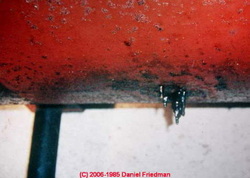|
Your home’s underground oil tank may have helped keep you and your family warm through dozens of cold winters. However, nothing lasts forever. Whether it has sprung a leak, is in need of an upgrade or has become obsolete, you may be considering getting rid of it. If so, you must understand exactly what is involved. There’s far more to the process of removing an old vessel than simply digging it out of the ground. The process is too complicated for a typical homeowner to attempt as a do-it-yourself project, for a variety of reasons. The size of the tank, the type of equipment needed and the environmental impact the removal process can have make it necessary to call in professionals under most circumstances. Still, you should be familiar with the process. Here are the most important steps involved in removing an underground oil tank. Step 1: Locating the TankDepending on how familiar you are with your property, you may be unsure of the exact location of the underground oil storage tank. Even if you are certain about the location, the professionals from a company specializing in tank removal can help determine whether other utilities are in close proximity and how that affects the removal process. Step 2: Creating a PlanOnce the location of the oil tank is determined, a specific plan can be drawn up for this complex undertaking. It’s essential to plan as much of the removal process as possible ahead of time to avoid unforeseen delays. A comprehensive plan can even include post-removal actions such as replacing the topsoil for your yard and garden. Step 3: Getting the Proper PermitsEven though the removal process takes place on your property, the type of work typically will require approval from your local governmental bodies. The company removing your oil tank will do research about the necessary permitting. A failure to get the proper permits could result in your project being halted. Step 4: Using the Right EquipmentIf space around the oil tank allows it, a backhoe typically will be used to help remove the oil tank. A professional service provider is likely to have this and any other specialized equipment required to remove the tank. Step 5: Hiring an InspectorWhether or not it is required for your permits, hiring an inspector is almost always a good idea. Experience and expertise are needed to determine that the property has been cleared of hazardous substances and that any other potential post-removal issues have been mitigated. If you believe it may be time to have your home’s oil tank removed for any reason, there’s a lot to consider. Willard Environmental Group has the capabilities and knowledge necessary to carry out every essential step. To make the process as easy and worry-free as possible, reach out to us for a quote today. Why Is My Oil Tank Leaking?
When it’s in good working order, your property’s oil tank helps keep you and your family warm. When it isn’t, it can spring a leak that leads to serious problems. Any leaks can mean a costly and disruptive cleanup process to remove harmful contaminants from the soil. With that in mind, it’s important to know how and why your oil tank may be leaking. With this information, you may be able to avoid a leak or at least pinpoint the cause. Reason No. 1: Water Outside the Tank Most leaks are caused by corrosion, which is why it’s essential for it to have a protective coating. Otherwise, rainwater that seeps into the ground will create rust on the outside of the walls and lead to a breakdown in its integrity. Reason No. 2: Water Inside the Tank If there is moisture inside, it can condense on the walls and lead to the metal becoming corroded. There are a number of ways in which water could be introduced into it — such as inferior fuels or seepage into the pipes feeding it. Reason No. 3: The Water Table Whenever digging on your property, you should always be aware of where the water table is. This is the point at which you will begin to encounter groundwater in the soil. If yours is buried below this level, it could mean moisture is pooling around it all the time, which in turn creates corrosion. Reason No. 4: Poor Construction There’s a much greater chance that your equipment will fail if it is made from inferior materials or with shoddy construction. If you choose the cheapest option in the hope you’ll save a few dollars, you could end up paying for it later. It’s also important to note that poor construction can make it more likely that water will get inside the oil tank. Reason No. 5: Loose Connections Always make sure the pipes connecting the oil tank to the house are tight and secure. Not only could fuel start leaking into the ground from loose connections, but moisture from the ground could find its way in, as well. Reason No. 6: Bacteria Microscopic bacteria can take residence inside your oil tank. Over time, they will leave corrosive materials that will eat through the metal. This is why you should have a protective coating on the inside as well as the outside. There are many reasons why your underground storage tank may be leaking. However, no matter the source of the problem, Willard Environmental Group has the solution. Our complete repair services can ensure that any issues are dealt with and any contamination is cleaned up and completely removed. For more information about our capabilities, visit our leak repair service page. When it comes to successful home renovation projects, choosing the right contractor for the job is an important first step. Whether you're remodeling a bathroom, building a deck or removing an underground storage tank, slow down and do some research. If you don't choose the right contractor, you could end up disappointed in the work, feeling swindled and needing someone else to finish the job.
Oil Tank Leak Rates Reported in Real Estate Publications Real Estate Publications, while reluctant to scare home owners and buyers by aggressive reporting on leaky oil tanks (which can involve a very large cleanup expense), also cite the concern for leaking oil tanks.
We know very little of the human health effects caused by fuel oils. Daily use of a kerosene stove for cooking should not cause any breathing problems for most people. People who use kerosene stoves to cook do not have more colds than people who have other types of stoves. Breathing moderate amounts of deodorized kerosene (fuel oil no. 1) has been shown to slightly affect the ability to smell and to cause a taste sensation. Numerous case-studies have reported accidental poisoning in children as the result of drinking kerosene.
When we observe evidence that a buried fuel storage tank is located at a property and when no other information is known about the type, condition, or even exact location of the tank, underground tank leaks, environmental damage, local water or well contamination, and a costly cleanup are potential risks to the property owner.
Underground fuel storage tanks usually fail from rust perforation from the inside of the tank, due to several effects of water inside the tank including, in the case of heating oil, combination of water with sulphur in the fuel.
So if a test shows that there is a lot of water in a buried oil tank one would be more pessimistic about its remaining life. Hire an expert to find hidden or buried tanks, abandoned tanks, or to test existing tanks: Willard Environmental Group Inc has equipment to test buried tanks for leaks. Tanks and soil around and below tanks are tested for evidence of leakage using:
|
Billy Willard, Author
I have been involved in the environmental consulting field since 1995. I have been involved in removing and the remediation of hundreds of oil tanks. Archives
January 2019
Categories
All
|


 RSS Feed
RSS Feed